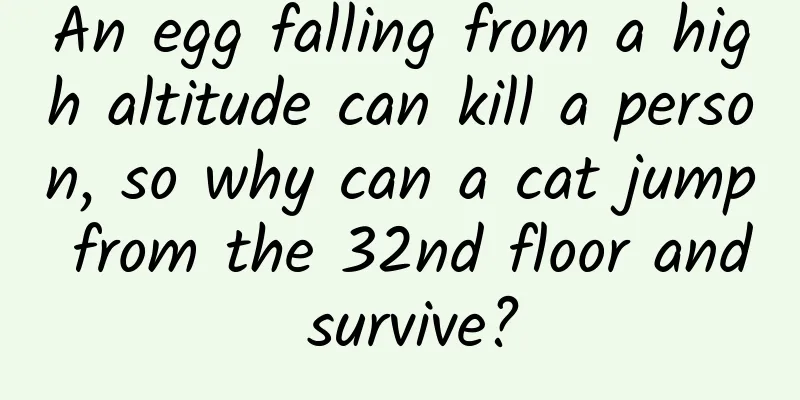An egg falling from a high altitude can kill a person, so why can a cat jump from the 32nd floor and survive?

|
Editor’s Note: Please do not conduct any tests or experiments on cats or other animals. In 2018, there was a miraculous news story in New York City: a cat fell from a 32-story window of an apartment building onto an asphalt road. Shockingly, although the high-altitude fall caused its lungs to collapse and its teeth to shatter, it was not in danger of death. The four-legged friend only spent two days at the veterinarian's and was able to go home. There have been many similar reports of cats falling, which gave rise to the saying "cats have nine lives". For decades, researchers from different disciplines have been trying to understand: Why do cats have such amazing survival skills? Image source: Pixabay Yet it wasn’t cats falling from dizzying heights that initially baffled physicists in the late 19th century. Rather, it was a series of photographs of cats pivoting as they fell, eventually landing on all fours. The photos show a person grabbing a cat by its legs, letting it fall with its back facing the ground, and then letting go. The cat is upside down with its back facing the ground for the first half of its flight, but the second half of the flight in the photos seems to defy the laws of physics: the cat flips over and lands on all fours. Violating the laws of physics? We can observe in everyday life that these quadrupeds can rotate in the air. According to the law of conservation of angular momentum, it is absolutely impossible for an initially non-rotating object to rotate on its own without the action of an external force. Therefore, for a long time, people believed that the momentum of the cat's rotation in the air came from the force exerted by the cat when it pushed itself off the plane when it fell . However, the photos showed the exact opposite: at first the cat fell straight down, and then it managed to rotate around itself. How is this possible? Many scientists had tried to explain the cat-fall phenomenon, including James Clerk Maxwell, the father of electromagnetism, who conducted a series of experiments in which cats were dropped from various heights (including from open windows) onto beds and tables. But it wasn’t until 1969 that the mystery was solved. It turns out that we haven't looked closely enough at the cat's body. It's not like we thought it was - a cylinder that starts spinning in midair. If you look closely, you might find that as the cat falls, its upper and lower bodies rotate in different directions, which ensures that angular momentum is conserved throughout the process . It's a bit like a pepper grinder, where the cat's body is divided into two parts, each rotating in different directions, so that the overall angular momentum change is zero. But how do cats keep their paws on the ground? In fact, cats are masters of physics ! They take full advantage of the laws of physics of classical mechanics: by keeping their front paws close to their bodies, they reduce the moment of inertia like a figure skater, and their upper body quickly rotates on its own axis; and for their hind legs, they do the opposite - stretching their hind legs to increase the moment of inertia as much as possible. This way, when their upper body rotates a large angle, their hind legs only need to rotate a smaller angle in the opposite direction. (Luckily, cats have incredibly flexible spines.) Once the cat's upper body is in the correct position (with its head pointing toward the ground), it can extend its front paws, tighten its hind legs and begin to grind pepper in the opposite direction so that its hind paws are also pointing directly toward the ground. In this way, the cat can always land successfully on all fours - without violating any laws of physics. How high can you fall to survive? The laws of physics dictate that the higher an object falls, the greater the impact. But a study from the 1980s found something unusual—at least for cats. In the study, two New York City veterinarians described 132 cases of cats falling from buildings between June and November 1984. All of the falls were from about 32 stories, and overall, 90 percent of the cats survived. As the two veterinarians documented the cats' injuries, they came to a surprising conclusion: The severity of the cats' injuries increased with height below seven stories, but above seven stories, their injuries seemed to decrease. In other words, a fall from six floors was more dangerous than a fall from 11 floors. Image source: Pixabay It seems that cats have challenged the laws of physics once again. The higher a cat falls from, the longer it is accelerated by the earth's gravity, so its falling speed should be getting faster and faster until it finally hits the ground. The sudden impact may cause their bones to break, lungs to collapse, or even other worse results. In theory, the higher the fall, the worse the outcome will be. However, if we think about the free fall of a cat in this way, we ignore the effect of air resistance. After all, the cat is not moving in a vacuum, but in air, which slows its fall. In fact, there are two opposing forces acting on the cat as it falls: gravity and friction, which slows it down. In an ideal situation with no air resistance, the calculation of gravity is simple: just multiply the mass of the cat by the acceleration due to gravity. Air resistance depends on the cross-sectional area of the object moving through the air, the drag coefficient, the density of the air, and the speed of the falling object. At the beginning of the fall, the cat's speed is zero, so only the acceleration caused by gravity acts on it, but as the speed continues to increase, friction will occur in the opposite direction of gravity. Therefore, in order to determine the specific movement of the animal, it is necessary to calculate the resultant force it is subjected to (gravity-friction). The size of the resultant force determines the size of the object's acceleration, as well as the direction. The speed limit of a cat falling But if the cat falls quickly for a while, its speed increases to the point where the friction force and gravity cancel each other out, which will cause the net force on the cat to become zero. Of course, the acceleration will also become zero. No more acceleration means that the cat's falling speed will not increase any more, and it has reached the limit of its falling speed. You can easily calculate this terminal velocity, or maximum speed limit, because terminal velocity occurs when friction and gravity are equal in magnitude, in which case the two forces cancel each other out and a falling object plummets toward the ground at a constant speed. Assume that a cat weighs 4 kilograms, is about 50 centimeters long and 15 centimeters wide. Based on these parameters, and considering the cat as a cylinder, we can calculate that the cross-sectional area of the animal is 0.075 square meters. Finally, we can infer that the cat's final speed is 32.68 meters per second, which is equivalent to just under 120 kilometers per hour. Based on the height the cat falls, its final velocity can be calculated. Image credit: Wissenschaft/Manon Bischoff, courtesy of Buckyball Design As you can see from the picture, at a fall of 100 meters, the cat has reached a speed of 30 meters per second. Because cats have been observed to survive falls from taller buildings (such as from the 32nd floor), they should be able to survive impacts of up to 120 kilometers per hour. Therefore, in theory, these animals may be able to survive falls from any conceivable height. Surviving cat bias? But this calculation of the cat's falling speed limit does not explain the New York veterinarian's observation : Why do cats have a higher chance of surviving a fall from the seventh floor or higher than from a lower floor? After all, the speed of the fall from a lower floor is lower and the impact force is smaller. One explanation has to do with the animal's experience. When a cat falls from a lower height, it is weightless for a short period of time. Therefore, it will instinctively stretch its legs under its body and land on all fours. However, this strategy fails when falling from a height: due to the uneven distribution of the animal's weight, stretching the legs under to align them can lead to serious injuries. This difference may explain why the survival rate decreases with height below the seventh floor. Falling from a higher altitude, the friction becomes more significant during the fall. The veterinarian speculates that the cat no longer has the feeling of falling, it will feel relaxed and will not stretch its legs. Its weight will be more evenly distributed, and the landing will be smoother, so the chance of survival is greater. But there's a simpler explanation for the phenomenon -- though it may be frustrating for animal lovers. The veterinarians' findings may reflect something called survivorship bias: If a cat dies instantly after falling from a height, owners may not bother to visit a veterinarian. So the number of unreported deaths may be higher than the number recorded by medical personnel. Planning and production Source: Global Science (ID: huanqiukexue) By Manon Bischoff Translation | Zhang Xianghe Editor: Yinuo |
<<: Where is the starfish's head? A new answer to the age-old mystery
>>: Is ESA ready to develop a commercial version of "Courier Boy"?
Recommend
Perl language entry to mastery video course
Perl language entry to mastery video course resou...
The dirty tricks ransomware uses to fool us
[[167210]] Finding ransomware... Today, ransomwar...
Which is more harmful: eating midnight snacks or staying up late and being hungry?
This article was reviewed by Pa Li Ze, chief phys...
No need for surgery? This technology can "freeze" breast tumors to death!
Breast cancer is the most common cancer affecting...
Did you know that animals also have growth rings, but they are hidden deep inside?
You must have heard of tree rings, which are conc...
International Museum Day丨Amazing! Take a look at these fashion items of the ancients
To create a sense of fashion, exquisite small ite...
How to increase website traffic? 100 Ways to Increase Website Traffic
1. Add a blog to your website. If your website is...
KOL marketing promotion, how does KOL bring products?
Currently, more and more brand owners choose KOL ...
Taking stock of the 4 business models of private domain traffic!
All business marketing models are ultimately for ...
Useful Information | A Beginner’s Guide to Planning for Marketers!
The core work of planning is to help companies fo...
BYD reveals that many of its employees were involved in corruption: privately opening casinos, accepting bribes, and many people were arrested
Many employees of BYD (002594.SZ), a leader in ne...
Can you do scientific experiments at home? Come and find out!
As people's living conditions are getting bet...
Scientific Decoding of "Spontaneous Human Combustion": The Scientific Basis Behind the Mysterious Phenomenon - The Wick Effect
At the turn of summer and autumn in 2001, a horri...
"Iris photography" suddenly became popular! Is it safe? Doctors warn...
Recently, a new type of "iris photo" ha...
Sony MDR-EX750BT Bluetooth headphones are a new faith for young people
In 2015, Sony released the h.ear series of produc...

![[Popular Science of Chinese Military Technology] As the "King of Rolls" among cruise missiles, what are the outstanding features of the Haiyan nuclear-powered cruise missile?](/upload/images/67f225be78d01.webp)







